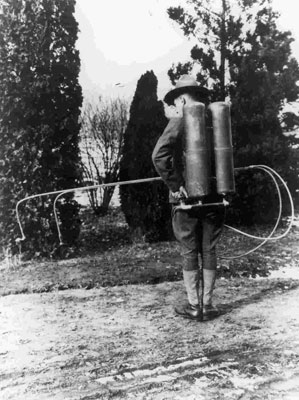
The Germans began developing flamethrowers shortly before WWI, and during the war developed and improved several models. Flamethrowers were developed as a shock weapon to break out and penetrate the trench defensive. Shock troops employed flamethrowers, grenades, and automatic weapons in a blitzkrieg-like strike. By WWII, the German army had excellent flamethrowers and well trained squads to use them.
The United States did not develop a flamethrower during WWI and there was no research and development until the beginning of WWII. At that point, the Kincaid Fire extinqisher Co was given 90 days to develop the M1. This was largely a failure, and tremendous research was invested in developing the second model. The M2 was considered to be the most outstanding flamethrower of WWII. All of the M2-2 research and development was done in a short period of time by industry, universities, various branches of the Army and additional features were copied from other countries. Much of the information needed to compile the whole story is scattered and lost. Each of the few books on flamethrowers required monumental effort to compiling and in the case with my book, recreating the information by actually examining and firing flamethrowers.
Flamethrowers were only fully utilized in the War in the Pacific in WWII. There was never a time when the enemy was more determined and entrenched. Flamethrowers were the most effective weapon, and therefore were well developed in both physical features and tactical use. When the very reliable and effective M2-2 was finally available and the Marine Corps had developed the tactics, the flamethrower was used with great success against the Japanese.

In Europe, the distances were much greater with less vegetation for hiding. The short ranged flamethrower was not as effective, and the need for routing dug in soldiers did not exist. Our allies had good models developed from WWII, including backpack and vehicle mounted models. Flamethrowers were used in a few isolated cases, but they mostly stayed in the rear until needed. Surprisingly, Patton discovered toward the end of the War in Europe, that when bunkers were surrounded and a flame tank fired a quick burst in front of the bunker, the Germans would surrender en mass.
For in-depth accounts of the US Flamethrower, go online to the Center for Military History at www.history.army.mil. This account covers the battle-by-battle use of flamethrowers against the Japanese in The War in The Pacific.
